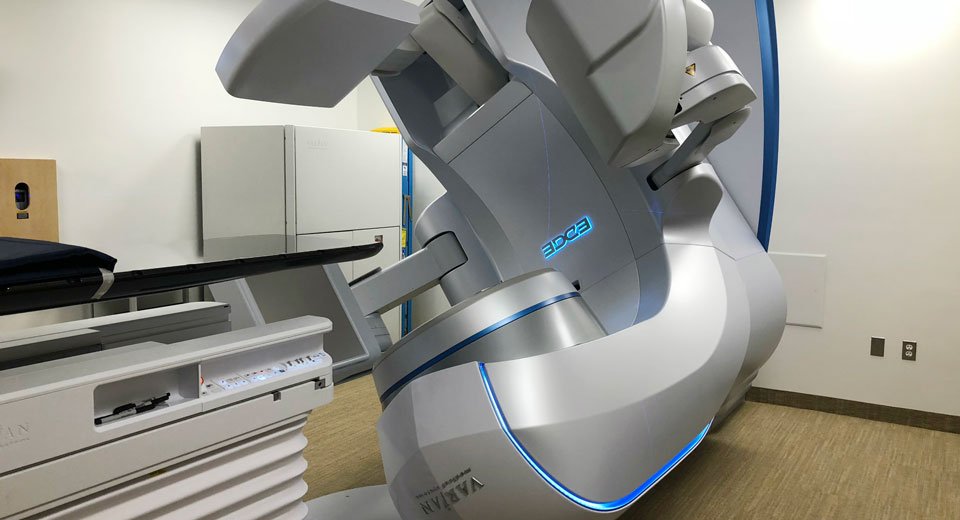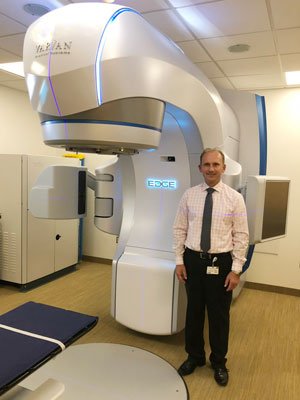New cancer technology comes to Cape Cod Hospital
Cancer patients at Cape Cod Hospital now have access to radiation oncology technology that only two other healthcare systems in the country have - HyperArc delivery with the Edge Radiosurgery System.
The unit, made by Varian Medical Systems, is a state-of-the-art machine that has the latest software, different energies, high-definition collimators, PerfectPitch couch, optical surface monitoring and onboard imaging in the form of a CT scanner. These qualities make it extremely precise in delivering targeted radiation to the exact location it is needed without damaging normal tissue, explained Gabor Menyhart, chief physicist at Cape Cod Radiation Therapy.
The unit can be used on any kind of cancer or tumor, but it is specifically designed for precision in the brain.
“The stereotactic radiosurgery technique that we do on the brain is called HyperArc,” Menyhart said. “We’re the third healthcare system in the United States who’s doing it, so that’s very exciting.”
HyperArc high definition radiotherapy is designed to irradiate multiple lesions in the brain at the same time without repositioning the patient, which saves time and makes procedures less stressful for patients.
“Stereotactic treatment used to take 45 minutes,” Menyhart said. “This unit will get it done in 10 minutes.”
One of the important aspects of radiation is that you want to block the normal tissue and only treat the actual tumor or lesion. The Edge has what are called “high-definition multi-leaf collimators” that are only 2.5 millimeters thick at the center. The machine it replaced had “leaves” that were 5 millimeters. The smaller size makes it much more precise and capable of treating smaller lesions in the brain, which is critical in cranial radiosurgery, Menyhart said.
Lung Cancer Treatment
 The Edge is also useful for treating lung cancer because it has a “gating” system. Gating means the door for the radiation beam open and closed automatically if the machine senses any movement on the part of the patient. When treating tumors in the lung, the breathing of the patient means that the tumor moves, so patients used to have to hold their breath for 30 seconds at a time. With other cancers, such as liver or prostate, the patient’s bladder can fill or they may have gas in their stomach that creates movement. Or a patient could sneeze or involuntarily move.
The Edge is also useful for treating lung cancer because it has a “gating” system. Gating means the door for the radiation beam open and closed automatically if the machine senses any movement on the part of the patient. When treating tumors in the lung, the breathing of the patient means that the tumor moves, so patients used to have to hold their breath for 30 seconds at a time. With other cancers, such as liver or prostate, the patient’s bladder can fill or they may have gas in their stomach that creates movement. Or a patient could sneeze or involuntarily move.
In addition to the gating system, the unit also has multiple cameras that is an optical surface monitoring system. It senses any movement of the skin surface.
“With this machine, you can actually track the lesion and have the radiation beam on only when it is in a certain position, and otherwise it will shut off,” Menyhart said. “And it’s all automated; it’s not a manual intervention.”
The high and low energy capabilities are important because it allows for treatment tailored to individual patients. For example, a heavier set person would need higher energies that a smaller person.
The couch that a patient lies on in the machine also has special properties. The couch on older treatment units could only move up and down, in and out and left to right and rotate. The couch on the Edge can pitch up and down and roll side to side.
When patients lay down on the couch of the machine, it does a CT scan to locate the tumor or lesions. Afterwards the computer system performs an auto-match that is evaluated by the radiation oncologist outside the room and it will tell them how much the couch has to move in any direction to make the position absolutely perfect. The couch then does that automatically.
“When we calculate these radiation treatments, we get a CT scan initially and then the physician draws the tumor volume and all the surrounding normal tissue on the CT image,” Menyhart said. “The physician then writes a prescription for the energy we are going to use and how many times we are going to treat the patient, and then the dosimetrists will calculate treatment on a planning computer.”
The machine was painstakingly calibrated and beam data was collected to give the planning computer sufficient information to perform calculations, and to determine how much radiation to use for a treatment. It is incredibly precise. It also has several safety mechanisms in place. For example, since both the imaging arms and the couch move, it has a collision detection system and a patient detection system so that the machine never bumps into itself or the patient.
Most of the radiation oncology staff, like Menyhart, were already familiar with the work path of the machine because they have been working with a slightly less sophisticated version of it for seven years. But because of the differences in the couch and the software, they underwent intensive training provided by the manufacturer.
Breast Cancer Treatment
The older machine is still very much cutting-edge, with an imaging system and high energy capabilities. It will be used for certain cancers, such as breast cancer, especially if the lymph nodes are involved. Breast cancer requires a large field of radiation and because the Edge has a limited field size, the patient would have to be moved several times during treatment, which is not ideal.
Five years ago, the hospital would not have been able to put a unit like the Edge in the existing room because of size limitations, Menyhart said. But just like computers and other electronic devices, radiation machines are getting smaller and more compact.
“Within the last 15 years everything just became so much better and so much more accurate,” he said. “The same with the machines. It’s extreme how many changes have occurred.”
